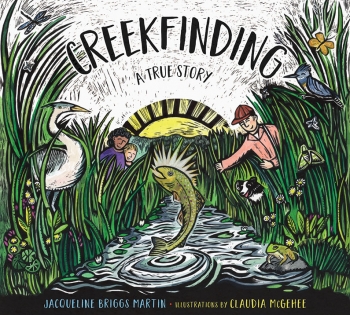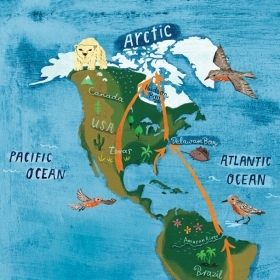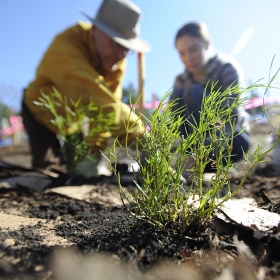“How does a creek get lost?” So begins Creekfinding, the inspiring, true-life tale by Jacqueline Briggs Martin ’66 of a trout creek buried beneath the Iowa prairie and of Mike Osterholm, the man who brought it burbling back to life, thus reviving a whole ecosystem.
“Lost is lost,” the naysayers in the book say. But Mike proves that what is gone can be recovered; you can catch brook trout in a former cornfield.
Creekfinding is lyrically written, yet with helpful footnotes explaining the hows and whys of creekbuilding. (How do you get the water flowing again? How do the fish make their way back?) Martin is also the author of the classic Snowflake Bentley, the true story of Wilson Bentley, the first-known photographer of snowflakes, which won the 1999 Caldecott Medal for its detailed woodcut illustrations by Mary Azarian. For those who know and love Snowflake Bentley, there is much to like in Creekfinding, which also showcases colorful, dynamic woodcuts, this time by Claudia McGehee.
Martin has carved a niche for herself in the competitive world of children’s picture books by focusing on the biographies (more than a dozen to date) of ordinary folk who do simple, yet extraordinary, things. This is refreshing in an era where so many of the biographies written for kids dwell on historical statesmen or popular sports stars. Martin’s perennial subjects are the dreamers, usually with a strong connection to nature, whose determination elevates them to the realm of the heroic.
So often the challenges in protecting our planet seem insurmountable. “How can I do anything about climate change when there are 7 billion other people in the world?” my own melancholic 8-year-old son has asked. But Creekfinding offers an antidote to such thinking: A single individual with a vision, no matter how seemingly impossible, really can make a difference. For older children, such as my son, the story provides inspiration and hope. For younger children, such as my 4-year-old daughter, it reflects what they love about the natural world: wading barefoot in the water, digging deep in the dirt.
Reading this story aloud to my three children has already inspired change in our local ecosystem. For two years we have participated in a weekly “forest school,” where my kids join a dozen others in free play along the ferny banks of a sandy creekbed. But our adventures have started to take a toll on the landscape, and so this year we are moving our base camp, to give the spot a chance to recover. My kids can’t wait to see what our creek looks like when we find our way back in a year’s time.
Ligon is a freelance writer and editor living in Mississippi, where she homeschools her three children, mainly out-of-doors. Follow her on Instagram @themotherofinvention.








We ask that those who engage in Wellesley magazine's online community act with honesty, integrity, and respect. (Remember the honor code, alums?) We reserve the right to remove comments by impersonators or comments that are not civil and relevant to the subject at hand. By posting here, you are permitting Wellesley magazine to edit and republish your comment in all media. Please remember that all posts are public.